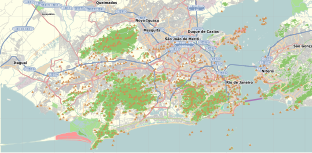You can help expand this article with text translated from the corresponding article in Portuguese. (July 2011) Click [show] for important translation instructions.
|
This article needs additional citations for verification. (December 2009) |
Native name: Ilha do Governador | |
|---|---|
 August 2016 satellite image | |
| Geography | |
| Location | Guanabara Bay |
| Coordinates | 22°48′21″S 43°12′37″W / 22.80583°S 43.21028°W |
| Area | 36.12 km2 (13.95 sq mi) |
| Administration | |
Brazil | |
| State | Rio de Janeiro |
| Municipality | Rio de Janeiro |
| Zone | North Zone |
| Administrative Region | Ilha do Governador |
| Demographics | |
| Population | 211,018 |
| Pop. density | 5,806.56/km2 (15038.92/sq mi) |
Governador Island (Ilha do Governador, in Portuguese; literally Governor's Island, in English) is the largest island in Guanabara Bay, in Rio de Janeiro, Brazil. It has a population of about 211,018 inhabitants, in a small area of 42 km2 (16 sq mi).
Rio de Janeiro's main airport, Galeão - Antônio Carlos Jobim International Airport, and the Galeão Air Force Base are located on Governador Island and occupy about a third of it, in the western and northwestern parts. A small sea inlet that once existed on the northwestern shore was landfilled to build the airport's runway 10/28, thereby increasing the island's area.
Often mentioned by cariocas (inhabitants of Rio city) simply as Ilha ("island"), Governador Island has some favelas, such as Morro do Dendê, the largest one, but it also has many middle-class neighborhoods, like Jardim Guanabara, with the third highest HDI in the city. The island is connected to Fundão Island and to the mainland by a complex of expressway bridges and through a ferry in Cocotá Terminal, transporting passengers to downtown Rio.
The name means "Governor's Island" because one of the first colonial governors of Brazil built a country house on the island in the 16th century. The native name for the island in Old Tupi was Paranapuã, which means "sea branch".
People from Governador Island suffer from high pollution from Guanabara Bay. Although surrounded by beaches, many of them have become unusable even though the bay has been cleaned up in recent years for the 2016 Summer Olympics.
The island is home to only one professional football club, A.A. Portuguesa. Its home is Estádio Luso Brasileiro, which in recent years has been expanded so it can be used professionally by Botafogo, as Estádio Olímpico João Havelange, its normal home, is being used for Olympic purposes. It was also used by Flamengo during 2017 and 2018, in the time being called Ilha do Urubu.[1]
- ^ "Fim da Ilha do Urubu! Flamengo rescinde contrato com a Portuguesa | Flamengo | O Dia". Archived from the original on 2023-04-17. Retrieved 2023-06-16.
